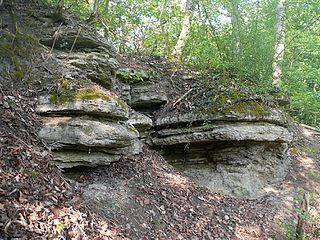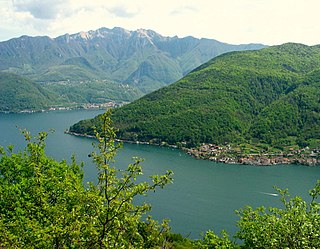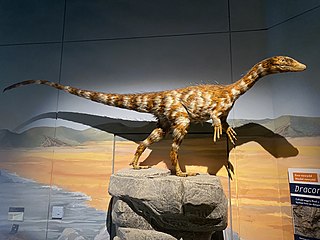
The Jurassic is a geologic period and stratigraphic system that spanned from the end of the Triassic Period 201.4 million years ago (Mya) to the beginning of the Cretaceous Period, approximately 145 Mya. The Jurassic constitutes the middle period of the Mesozoic Era as well as the eighth period of the Phanerozoic Eon and is named after the Jura Mountains, where limestone strata from the period were first identified.

The Early Jurassic Epoch is the earliest of three epochs of the Jurassic Period. The Early Jurassic starts immediately after the Triassic–Jurassic extinction event, 201.3 Ma, and ends at the start of the Middle Jurassic 174.7 ±0.8 Ma.
The Rhaetian is the latest age of the Triassic Period or the uppermost stage of the Triassic System. It was preceded by the Norian and succeeded by the Hettangian. The base of the Rhaetian lacks a formal GSSP, though candidate sections include Steinbergkogel in Austria and Pignola-Abriola in Italy. The end of the Rhaetian is more well-defined. According to the current ICS system, the Rhaetian ended 201.4 ± 0.2 Ma.

In the geologic timescale, the Anisian is the lower stage or earliest age of the Middle Triassic series or epoch and lasted from 247.2 million years ago until 242 million years ago. The Anisian Age succeeds the Olenekian Age and precedes the Ladinian Age.

The Carnian is the lowermost stage of the Upper Triassic Series. It lasted from 237 to 227 million years ago (Ma). The Carnian is preceded by the Ladinian and is followed by the Norian. Its boundaries are not characterized by major extinctions or biotic turnovers, but a climatic event occurred during the Carnian and seems to be associated with important extinctions or biotic radiations. Another extinction occurred at the Carnian-Norian boundary, ending the Carnian age.
The Hettangian is the earliest age and lowest stage of the Jurassic Period of the geologic timescale. It spans the time between 201.3 ± 0.2 Ma and 199.3 ± 0.3 Ma. The Hettangian follows the Rhaetian and is followed by the Sinemurian.

In the geologic timescale, the Sinemurian is an age and stage in the Early or Lower Jurassic Epoch or Series. It spans the time between 199.5 ±0.3 Ma and 192.9 ±0.3 Ma. The Sinemurian is preceded by the Hettangian and is followed by the Pliensbachian.

The Late Triassic is the third and final epoch of the Triassic Period in the geologic time scale, spanning the time between 237 Ma and 201.4 Ma. It is preceded by the Middle Triassic Epoch and followed by the Early Jurassic Epoch. The corresponding series of rock beds is known as the Upper Triassic. The Late Triassic is divided into the Carnian, Norian and Rhaetian ages.

The Ladinian is a stage and age in the Middle Triassic series or epoch. It spans the time between 242 Ma and ~237 Ma. The Ladinian was preceded by the Anisian and succeeded by the Carnian.
The Norian is a division of the Triassic Period. It has the rank of an age (geochronology) or stage (chronostratigraphy). It lasted from ~227 to 208.5 million years ago. It was preceded by the Carnian and succeeded by the Rhaetian.

Avalonnectes is an extinct genus of small-bodied rhomaleosaurid known from the Early Jurassic period of the United Kingdom. It contains a single species, A. arturi.

Stratesaurus is an extinct genus of small-bodied rhomaleosaurid plesiosaur known from the Early Jurassic period of the United Kingdom. It contains a single species, S. taylori. It was a small plesiosaur, with a skull length of 18 cm (7.1 in) and a body length of 2 m (6.6 ft).

Eoplesiosaurus is an extinct genus of basal plesiosauroid known from the Early Jurassic period of the United Kingdom. It contains a single species, E. antiquior.

Waterloo Bay is an area of foreshore in Larne on the east coast of County Antrim, Northern Ireland. It is of particular interest to geologists because it provides a clear, complete and accessible example of the sequences from Upper Triassic to Lower Jurassic, when the rock types changed from land to marine.
The Gabbs Formation is a geologic formation in Nevada. It preserves fossils dating back to the Late Triassic and Early Jurassic periods, and is one of the few formations in the United States known to include the Triassic-Jurassic boundary. In 2007, an exposure of the Gabbs Formation at New York Canyon was proposed a candidate GSSP for the Hettangian stage, the first stage of the Jurassic. However, the New York Canyon section was ultimately not selected as Hettangian GSSP, which instead went to the Kuhjoch section of Austria in 2010.
The Kendlbach Formation is a Late Triassic to Early Jurassic (Hettangian) geological formation in Austria and Italy. It contains the Global Boundary Stratotype Section and Point (GSSP) for the Hettangian stage at the Kuhjoch section in the Karwendel Mountains of Austria.
The Oberrhaet Formation, also known as the Oberrhaet Limestone, is a Late Triassic (Rhaetian-age) geological formation in Austria. It is a unit of massive dark grey bioclastic limestones, found within the Northern Calcareous Alps. The Oberrhaet Limestone was originally a series of reefs which developed on the northwest edge of the Eiberg Basin, a narrow marine waterway extending along the northwestern tip of the Neotethys Ocean. The center of the Eiberg Basin is nowadays preserved as the Eiberg Member of the Kössen Formation, which was deposited southeast of the Oberrhaet Limestone and interfingers with it in many areas. The Oberrhaet Limestone was very similar to the Dachstein Limestone, which represented carbonate platforms and reefs on the southeast edge of the Eiberg Basin. The most prominent components of the reefs were giant frond-like colonies of Retiophyllia, a scleractinian coral.

Dracoraptor is a genus of coelophysoid dinosaur that lived during the Hettangian stage of the Early Jurassic Period of what is now Wales dated at 201.3 ± 0.2 million years old.
The Pignola-Abriola section is a ~63 m long stratigraphic sequence of cherty limestones deposited in the Lagonegro Basin during the latest Norian and the early Rhaetian Stages. The main outcrop is on the western side of Mount Crocetta along the SP5 road connecting the villages of Pignola and Abriola. A smaller outcrop, overlapping the central part of the main section, is located near a former railway tunnel, few meters below the road level. The Pignola-Abriola section has been recently proposed as GSSP of the Rhaetian Stage.

Palaeontology in Wales is palaeontological research occurring in Wales.













